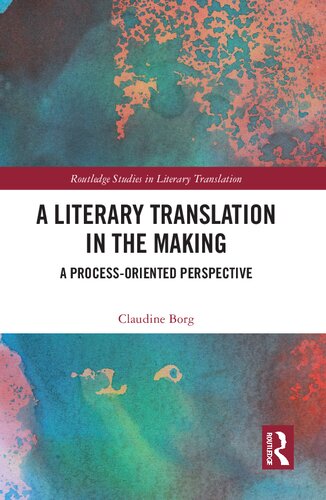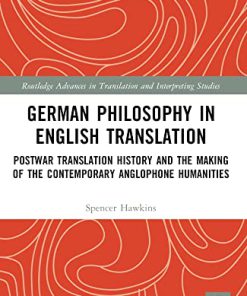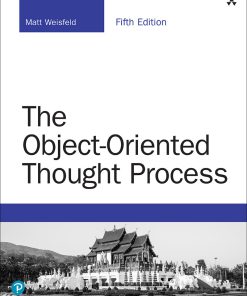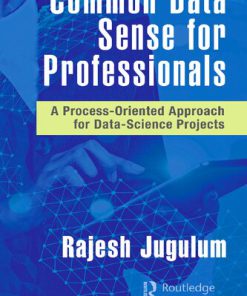A Literary Translation in the Making A Process Oriented Perspective 1st Edition by Claudine Borg ISBN 9780367714383 0367714388
$50.00 Original price was: $50.00.$25.00Current price is: $25.00.
A Literary Translation in the Making A Process Oriented Perspective 1st Edition by Claudine Borg – Ebook PDF Instant Download/Delivery: 9780367714383 ,0367714388
Full download A Literary Translation in the Making A Process Oriented Perspective 1st Edition after payment

Product details:
ISBN 10: 0367714388
ISBN 13: 9780367714383
Author: Claudine Borg
A Literary Translation in the Making A Process Oriented Perspective 1st Edition Table of contents:
1 Theoretical Framework: Venturing beyond classic process-oriented research
Cognitive Translation Studies: An overview
1.2 The three phases of the translation process
1.3 Decisions in the translation process
1.3.1 Definitions
1.3.2 The structure of decisions
1.3.3 Conscious and unconscious decisions
1.4 Alternative translation solutions, postponed decisions and choices
1.4.1 Choosing between ATSs
1.4.2 Written ATSs: Empirical evidence from the literature
1.5 Revision in CTS
1.5.1 Definitions
1.5.2 Self-revision
1.5.2.1 How is self-revision defined in the literature?
1.5.2.2 Empirical studies of self-revision
1.5.2.3 The effect of self-revision on the translation process: Do self-revisions deliteralise the final translation?
1.5.3 The post-drafting phase
1.5.4 The post-translation process and other-revision
1.6 Individual variation in translation processes
1.7 Literary translation in CTS
1.8 Studies of draft translations
1.9 Ethnographic approaches in CTS
1.10 Case studies and generalisation in TS and CTS
Notes
2 Context
The wider context: The “typical” literary translator
2.2 The specific context
2.2.1 The coming into being of Maltese
2.2.2 The local scene: The book market and literary translation in Malta
2.2.3 The translator
2.2.4 The ST and its author
Notes
3 Methods and Data
Research design
3.1.1 Data and data collection methods
3.1.2 A multi-method approach
3.1.3 Field research: An ethnographic approach
3.2 Data analysis methodology
3.2.1 Data preparation
3.2.2 Data analysis methodology
3.2.2.1 Analysing revisions and written ATSs
3.2.2.2 Written ATSs come in different shapes and sizes
3.2.2.3 Linguistic categories
3.2.2.4 Going beyond the linguistic categories
3.2.2.5 The effect of self-revisions on the translation
3.2.2.6 The reasons behind the choice of ATSs in D2 and the self-revisions in D7
3.2.2.7 Analysing the interviews, the retrospective sessions and the TPPs
Notes
4 A Literary Translation in the Making
Part I. Analysis of the initial interview: How does the translator envisage his own literary translation process?
4.1.1 Overview of the phases from the initial interview: The translation process as conceived by the translator
4.1.1.1 Phase 1: Preparing the groundwork – the comprehension phase
4.1.1.2 Phase 2: Producing a draft translation
4.1.1.3 Phase 3: Fine-tuning phase – refining the draft translation
4.1.1.4 Phase 4: Polishing the style of the TL
4.1.1.5 Phases 5, 6 and 7: Self-proofreading, proofreading and self-correcting the text
4.1.1.6 Phase 8: The publication phase – typesetting, layout and printing
4.1.1.7 Translating Monsieur Ibrahim
4.2 Part II. Textual analysis of Draft 1
4.2.1 Succinct analysis of Draft 1
4.2.1.1 Lexical variety and translation strategies
4.2.1.2 Creative solutions
4.2.1.3 Paragraphing and sentence boundaries
4.2.2 The very first self-revisions: Online self-revisions in D1
4.2.2.1 Classification I: Linguistic categories
4.2.2.2 Classification II: The effect of OSRs on the TT
4.3 Part III. Rich description of the translator’s approach to the translation
4.3.1 Phase 3: Self-revision of Draft 1 yielding Draft 2
4.3.1.1 Routines, patterns and linearity
Other recurrent process routines
4.3.1.2 Essentially linear approach
4.3.1.3 Decision-making in Phase 3
4.3.1.4 Dictionaries and other influences
4.3.1.5 Exploring creative solutions and personal preferences
What happened to the creative solutions in D1 and what is their raison d’être?
4.3.1.6 Lexical variety
4.3.1.7 Thinking about think-aloud
4.3.2 Phase 4: Self-revision of Draft 2 yielding Draft 3
4.3.2.1 The translator’s approach to Draft 2
4.3.2.2 Type of self-revisions made and underlying motivations
4.3.2.3 Alternating between reading aloud and thinking aloud
4.3.2.4 The next step
4.3.3 Phase 5: Self-revision of Draft 3 yielding Draft 4
4.3.4 Phase 6: Proofreading of Draft 4 yielding Draft 5
4.3.4.1 Classification of other-revisions in Draft 5
4.3.4.2 Analysis of the first retrospective session (RS1)
4.3.5 Phase 7: Self-correcting the proofreader’s version
4.3.6 The retrospective interview: Looking back at the translator’s experience in this project and at his process up to Phase 7
4.3.7 Phase 8: The publication phase
4.3.7.1 Analysis of Draft 7
4.3.7.2 Analysis of Draft 8
4.3.7.3 Analysis of Draft 9
4.3.7.4 The final product
4.4 Part IV. Written alternative translation solutions
4.4.1 Written ATSs in Draft 1
4.4.1.1 Written ATSs come in different shapes and sizes
4.4.1.2 Distribution of written ATSs in D1
4.4.1.3 Linguistic categories
4.4.1.4 Going beyond the linguistic categories
4.4.2 Written ATSs: From Draft 2 onwards
4.4.2.1 The effect of written ATSs on the TT: Literality of the solutions in the published TT
4.4.2.2 Tackling the written ATSs: Reasons behind the solutions chosen in Draft 2
4.5 Summing up
Notes
5 From a Handwritten First Draft to the Published Version
5.1 The translation process
5.1.1 Phases: Their function and pace
Phase 1: Preparing the groundwork – the comprehension phase
Phase 2: Producing a draft translation
Phase 3: Redrafting – fine-tuning the draft translation
Phase 4: Polishing the style of the target language
Phase 5: Self-proofreading
5.1.2 A compartmentalised and incremental process resulting from strategic behaviour
5.1.3 Questioning the subdivision of the translation process into three fixed phases
5.2 The post-translation process
5.3 A process characterised by time gaps
5.4 Summing up
Notes
6 Decision-Making and Underlying Motivations
Alternative translation solutions
6.1.1 The structure of decisions: Accounting for written ATSs and postponed decisions
6.2 Self-revisions
6.2.1 Amount and type of self-revisions across the phases
6.2.2 The effects of self-revision on the TT
6.2.3 Reasons underlying translatorial decisions and choices
Contradictions or complexity of translatorial decisions?
6.2.4 Delving deeper into personal preferences, their roots and their reach
6.3 The translator’s self-concept
6.4 Matching intentions with actions
6.5 Summing up
Notes
7 Conclusion
Evaluation and implications of the findings
7.2 Limitations
7.3 Contributions
7.4 (Future-)Looking at the individual translator
Appendix 1: Evolution of the Translation – Corpus Sample
Appendix 2: Sample of a TPP (Extract)
Appendix 3: Analysis of Reasons behind the Choice of Written ATSs in D2 and Self-Revisions in D7
Appendix 4: Codes used in NVivo
Appendix 5: Phases 3 and 4 Sessions
References
Index
People also search for A Literary Translation in the Making A Process Oriented Perspective 1st Edition:
how much does a literary translator earn
translation literature
a literary tradition is quizlet
a literary tradition is
a literal translation of a text
Tags: Claudine Borg, Literary Translation, Process Oriented Perspective
You may also like…
Linguistics - Linguistics
The Routledge Handbook of Latin American Literary Translation 1st Edition Delfina Cabrera
Languages - Chinese Language Reference
Computers - Programming
The Object Oriented Thought Process 5th Edition Matt Weisfeld
Uncategorized
Uncategorized
Uncategorized











